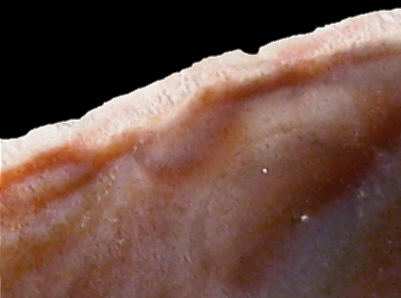
Foto: Jehanne Féblot-Augustins, 2005.
- Morestel
Sampled sites:
| Material name: | Km3 |
| Synonyms: | N/A |
| Material (geologic): | Late Jurassic (Late Kimmeridgian) flint |

Foto: Jehanne Féblot-Augustins, 2005. |
Sampled sites:
|
| Mode of occurrence: | Medium-sized ovoid nodules. |
| Cortex: | Pink, chalky with a powdery texture, 1 mm thick, transition sharp. |
| Colour: | Weak red with reddish grey schliers (10R 5/2 to 4/2, 10R 5/1 to 6/1). |
| Pattern: | Concentric banding, more distinct below the cortex but visible throughout the nodule. |
| Appearance: | Very homogeneous material, shiny, semi-opaque, very smooth and very fine-grained. |
| Structure: | No particular structure. |
| Texture: | Mudstone. |
| Matrix: | Pinkish, semi-opaque, rather cloudy. |
| Grains: | 1 to 5 %, white or stained red by iron oxides, subrounded with high sphericity to irregularly shaped, 100 µ (rare elements of 250 µ). |
| Grain composition: | Algae fragments ; numerous particles of iron oxide. |
| Further information: | Click here for the original French description (opens in a new window), or here for more information on the attributes used in the description (use your browser's "BACK"-button to return here). |
| Citing: | Information on citing this page can be found here. |
| Locality: | Morestel, France, Isère department |
| Synonyms: | Sampling site Bugey 42 after Féblot-Augustins |
| Geographical description: | As the site is deemed vulnerable to over-collecting, no further details are given. If you have any questions about the exact location of the source for scientific study, contact the author for further details |
| Geographical co-ordinates: |
east/x 845 north/y 2081 (Lambert zone II, NTF)
This corresponds roughly with |
| Co-ordinate precision: | As indicated above, this small site has to be protected from heavy exploitation. The coordinates above are accurate enough to get an idea where this material occurs, but deliberately too inaccurate to find the site on a map or with a GPS-receiver. |
| Geology: |
According to the geological map, the substrate belongs to the Late Kimmeridgian Tabalcon formation (unit J7-8). Map of all sampled localities of Kimmeridgian flint in the Bugey (PDF, 427 KB, opens in new window). |
| Type of source: | Primary. |
| Other types of flint: | Apart from the Km3 type, also both other known Kimmeridgian materials, Km1 and Km2, can be found here. |
thumb.jpg) Foto: Jehanne Féblot-Augustins, 2005 |
thumb.jpg) Foto: Jehanne Féblot-Augustins, 2005 |
| Last modified on: November 15, 2005 |
Contents primarily by: Jehanne Féblot-Augustins |
Comments to: |